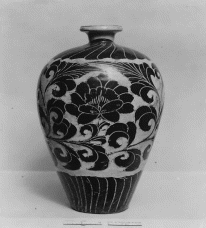
Formal perspective
This is a Cizhou-type Chinese vase, which relied on a complicated technique in order to create an outstanding decoration on a jar. This technique is sgraffito, an Italian term that means scratched. The potter would cover the jar with a white slip and then apply a black one. He would then carve the jar to create a design of a huge peony scroll (Yaw 1990 p. 29).
This vase has a short thin neck with a saucer-shaped opening. The jar has peony flowers and leaves. It has well-designed lines at the bottom and top that separates the body of the vase. Every design has a deep carve that runs across the surface of the vase. These carves show the dark slip underneath the white slip, which results in a different color tone and elements of natural shades.
Technical perspective
This vase is made of stoneware with black and white slips with cut decoration beneath a transparent glaze. Designers used the sgraffito technique to make this piece of vase. Sgraffito is a method of decorating a ceramic with paints.
Potters paint a coat of colored slip onto a leatherhard pot, and they then follow this step with carving all the way through the slip to show the clay beneath the surface. The technique requires a distinct color from the color of the clay. This is necessary to enhance the contrast and visibility of the vase when it is fired and glazed.
Cultural perspective
This vase is ornamented with several peonies. This was common among Chinese arts during the Northern Song dynasty. The jar is large with striking colors. Most Chinese considered leaves and flowers as symbols of rank and royalty. The symbolic relations in the peony flower made it to be called the flower of wealth and nobility.
Peonies and other related species were common in the traditional Chinese arts. These trees had large red flowers. Consequently, Chinese referred to them as the king of flowers. The Sui and Tang Dynasties introduced the peony in Chinese royal gardens. Peony gained great recognition during the reign of Emperor Wu Zetian, who was the only woman to serve in that capacity in China. She took a great interest in peony.
As a result, several officials who wanted to gain recognition and advance their careers in the empire had to appreciate peony flowers. This led to a widespread use of the flower in China. The flower became a symbol of riches and rank.
Social perspective
Cizhou ceramic was made strong enough to withstand the pressure of daily use. Moreover, the large size of the vase made it suitable for common populace, who used it for general purposes. These qualities made the vase to be the ‘people’s ware’. Potters were able to try different styles in order to produce different styles of Cizhou ceramics by using glaze and slip techniques alongside brush and paints (Welch 2008 p. 34).
This jar served the normal roles of a vase. Chinese placed flowers inside the vase. It was also a drinking ware or a container for wine or liquor. Although this vase does not have any words or phrases on it, there were other vases with words and phrases, which had messages of good wishes, great life, or relationship. In this sense, Chinese believed that the vase had certain spiritual meanings.
Reference List
Metropolitan Museum of Art. Vase with Peony Scroll. Web.
Welch, Patricia. Chinese Art: A Guide to Motifs and Visual Imagery. North Clarendon, Vermont: Tuttle Publishing, 2008.
Yaw, Law. Lee Kong Chian Art Museum: Collection of Chinese Ceramics, Bronze, Archaic Jade, Paintining and Calligraphy. Singapore: Singapore University Press, 1990.